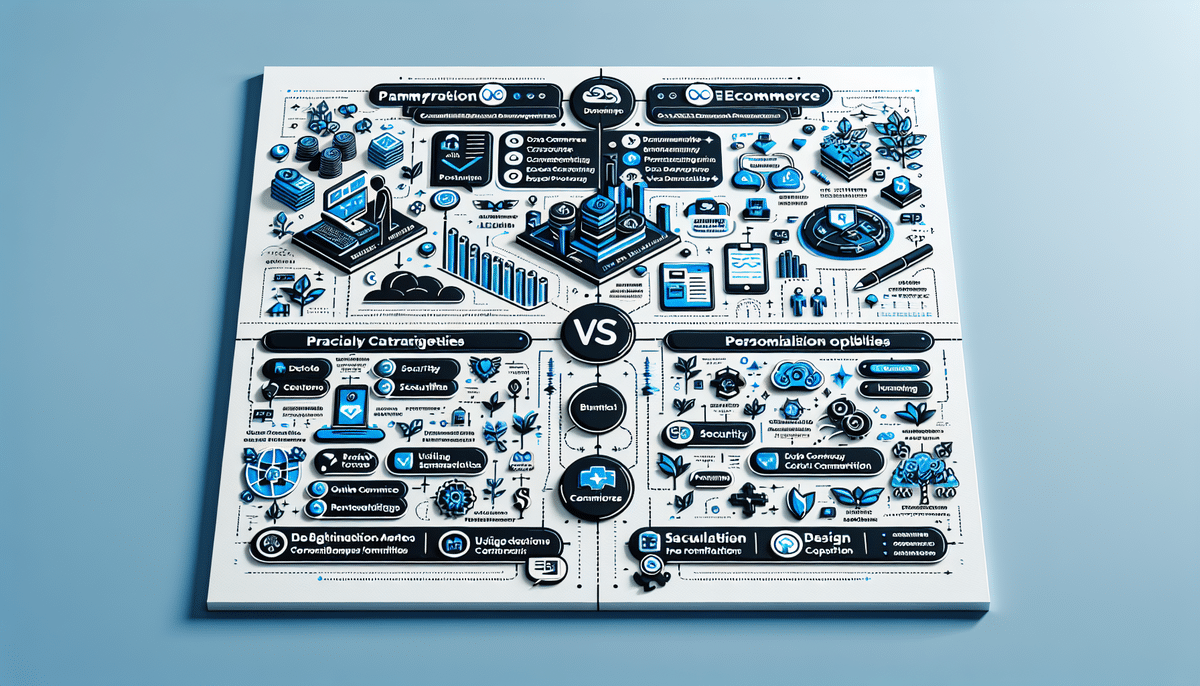Introduction to Shopify and Magento
When it comes to e-commerce platforms, Shopify and Magento (Adobe Commerce) are two of the most prominent choices available. While both platforms offer robust solutions for online businesses, they cater to different needs and scales. This comprehensive comparison will help you determine which platform aligns best with your business objectives.
Pricing Comparison
One of the most significant differences between Shopify and Magento lies in their pricing structures:
Shopify Pricing Plans
- Basic Shopify: $29/month – Suitable for new businesses.
- Shopify: $79/month – Ideal for growing businesses.
- Advanced Shopify: $299/month – Best for scaling large businesses.
Additionally, Shopify charges transaction fees ranging from 0.5% to 2% per sale, depending on the chosen plan. These fees can impact profitability, especially for high-volume stores.
Magento Pricing Options
- Magento Open Source: Free – Offers basic features with no ongoing costs.
- Magento Commerce: Starting at $1,600/month – Provides advanced features and dedicated support.
- Magento Commerce Cloud: Custom pricing – Includes cloud hosting and optimized performance.
While Magento's Open Source edition is free, it requires significant investment in development and maintenance. The Commerce editions cater to larger enterprises needing extensive customization and support.
Ease of Use and Design Customization
Shopify is renowned for its user-friendly interface, making it accessible for individuals without technical expertise. The platform features a drag-and-drop builder, allowing users to design and customize their stores effortlessly. Shopify also offers a vast library of responsive themes, both free and paid, which can be further customized using Shopify’s Liquid templating language.
Magento, on the other hand, is highly customizable but comes with a steeper learning curve. Its open-source nature provides unparalleled flexibility, enabling developers to modify virtually every aspect of the store. Magento’s theme customization requires knowledge of HTML, CSS, and PHP, making it more suitable for businesses with access to technical resources.
Features and SEO-Friendliness
Both platforms offer a comprehensive set of features tailored to e-commerce needs, but they differ in their approach and depth:
Shopify Features
- Built-in payment processing through Shopify Payments.
- Inventory management and order tracking.
- Extensive app store for additional functionalities.
- SEO tools like customizable meta tags, sitemaps, and clean URL structures.
Shopify’s mobile-responsive themes and integrated blogging platform enhance its SEO capabilities, helping stores rank better in search engine results.
Magento Features
- Advanced product management and categorization.
- Multi-store support for managing multiple storefronts from a single backend.
- Customer segmentation and personalized marketing tools.
- Robust SEO features, including canonical tags, rich snippets, and comprehensive URL management.
Magento’s flexibility allows for more granular SEO optimizations, which can be leveraged by businesses aiming for high search engine rankings.
Security, Payment Gateways, and Integrations
Security and payment processing are critical components of any e-commerce platform:
Shopify Security and Payments
- PCI DSS compliant, ensuring secure handling of payment information.
- Built-in SSL certificates for secure data transmission.
- Supports numerous payment gateways, including PayPal, Stripe, and Shopify Payments.
Shopify simplifies payment processing with its integrated solutions, reducing the need for third-party providers.
Magento Security and Payments
- Offers robust security features, including two-factor authentication and advanced user permissions.
- Requires manual setup of SSL certificates and PCI compliance measures.
- Supports a wide range of payment gateways through extensions and custom integrations.
Magento provides extensive security customization options, allowing businesses to adhere to specific compliance standards. However, this requires more technical management compared to Shopify.
Support, Scalability, and Performance
Both platforms offer scalable solutions, but their support structures differ:
Shopify Support and Scalability
- 24/7 customer support via phone, email, and live chat.
- Highly scalable cloud infrastructure, suitable for businesses of all sizes.
- Performance optimization handled by Shopify, ensuring fast load times and uptime.
Magento Support and Scalability
- Technical support is available through Magento Commerce subscriptions.
- Highly scalable with the ability to handle large product catalogs and high traffic volumes.
- Performance optimization relies on the user’s hosting environment and technical expertise.
Magento’s scalability makes it ideal for large enterprises, while Shopify’s managed infrastructure ensures consistent performance without requiring extensive technical oversight.
Migration and Choosing the Right Platform
Transitioning between platforms can be complex. Both Shopify and Magento provide tools to facilitate migration:
Shopify Migration
- Offers a free import tool for migrating from various platforms.
- Numerous migration apps available in the Shopify App Store.
- Extensive documentation and support to aid the migration process.
Magento Migration
- Provides a data migration tool for transferring data from other platforms.
- Requires more technical effort, often necessitating developer assistance.
- Comprehensive guides and community support to assist with migration.
Choosing the right platform depends on your business size, technical resources, and specific needs. Shopify is generally more suitable for small to medium-sized businesses seeking ease of use, while Magento caters to larger enterprises requiring extensive customization and scalability.
Which Platform is Right for Your Business?
Consider the following factors when choosing between Shopify and Magento:
- Business Size: Shopify is ideal for small to medium-sized businesses, whereas Magento is better suited for large enterprises.
- Technical Expertise: Shopify’s user-friendly interface requires minimal technical knowledge. Magento demands a higher level of technical proficiency.
- Budget: Shopify offers predictable monthly pricing, while Magento’s costs vary based on customization and hosting needs.
- Customization Needs: Magento provides greater flexibility for customization, making it suitable for businesses with unique requirements.
- Growth Plans: If you anticipate rapid growth or require advanced features, Magento may offer the scalability you need.
Pros and Cons of Shopify and Magento
Shopify Pros:
- Intuitive and easy to use.
- Low transaction fees with Shopify Payments.
- Vast app ecosystem for extended functionality.
- Reliable hosting with excellent uptime.
Shopify Cons:
- Limited customization compared to Magento.
- Additional costs for premium themes and apps.
- Transaction fees if not using Shopify Payments.
Magento Pros:
- Highly customizable and flexible.
- Advanced features suitable for large businesses.
- Robust SEO capabilities.
- Extensive community and developer support.
Magento Cons:
- Steeper learning curve.
- Higher total cost of ownership, including development and maintenance.
- Requires technical expertise to manage effectively.
Conclusion: Choosing the Right Platform for Your E-commerce Store
Both Shopify and Magento offer powerful solutions for building and managing online stores, but they cater to different business needs. Shopify excels in providing an easy-to-use, all-in-one platform ideal for small to medium-sized businesses looking for simplicity and reliability. In contrast, Magento stands out with its extensive customization options and scalability, making it the preferred choice for large enterprises with complex requirements.
Assess your business size, budget, technical capabilities, and specific e-commerce needs to make an informed decision. Whether you choose Shopify or Magento, both platforms have the potential to support and grow your online business effectively.
Tips for Maximizing Your Chosen Platform
- Research and Select the Appropriate Plan: Choose a pricing plan that aligns with your business size and expected growth.
- Leverage Built-In Features: Utilize the platform’s native tools for payment processing, inventory management, and SEO to streamline operations.
- Customize Thoughtfully: Invest in customization that enhances user experience without overcomplicating your store’s design.
- Utilize Extensions and Plugins: Enhance functionality with vetted apps or extensions to meet specific business needs.
- Optimize for SEO: Regularly update meta tags, improve site speed, and create quality content to boost search engine rankings.
- Monitor Performance: Use analytics tools to track sales, customer behavior, and site performance for continuous improvement.
- Ensure Security: Implement best practices for security, including regular updates, strong passwords, and SSL certificates.
- Seek Support When Needed: Don’t hesitate to reach out to support teams or hire experts to address complex issues or optimizations.
By following these tips, you can fully harness the capabilities of your chosen e-commerce platform, ensuring a successful and scalable online business.




















